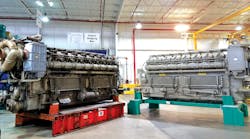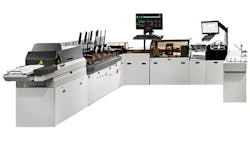For a while now, General Electric employees have described the former conglomerate as a digital industrial company. The phrase has a nice ring to it, and after shedding numerous divisions, most notably in finance, it’s pretty much accurate. Whenever the company wants to put that phrase into action, it opens the doors — quite literally — to one of its brilliant factories.
Its remanufacturing plant in Grove City, Pa. — located hard in the Rust Belt, about an hour north of Pittsburgh and about an hour east of Youngstown, Ohio — is one of those brilliant factories. Decades ago, the building served as a food packaging plant. Today, after almost $200 million in investments, it has become a high-tech home for the remanufacture of diesel engines for locomotives. Floors are almost spotless. Work stations are populated with sensors.
“We’re taking digital technologies that people are really comfortable with outside of work and bringing them into work — whether that’s iPads, or phones, or just visual data,” said Jamie Miller, the former GE senior vice president and CEO of GE Transportation who was just promoted to CFO. “It was something that people could readily see because they use it outside of work.”
That mindset has allowed the plant to transition from tearing down engines upon arrival into component parts, searching for what needed to be corrected, then running it through either a manufacturing or remanufacturing line and rebuilding it. “We did that the same way for every engine on every component,” Miller said. “Now when that engine comes in the door, we already know the wear and tear on each component in that engine. We know which ones need heavy work scopes and really serious repair, we know which ones need just a little brushing up and, actually, which ones don’t need any repair at all.
“It’s condition-based manufacturing, and we’re able to tailor what we do here to rebuild that engine faster and just be more productive when we do it.”
The end results? The plant brings in about 1,200 engines and sends out about 20,000 parts every year, and its reduction in unplanned downtime fluctuates from 10% to 20% of previous numbers. “We can turn those engines around faster,” Miller said, “and get them back into revenue service for our customers.”
Which is, of course, the bottom line with any technology. GE embodies the digital factory and the marriage of old manufacturing and new tech. Its brilliant factories — Grove City is one of less than a dozen around the world — revolve around lean manufacturing principles, additive manufacturing, advanced manufacturing technologies and digital manufacturing. Its industrial cloud platform, Predix, allows customers to replicate that on a smaller level, extending industrial automation to the cloud.
All that, though, remains at least somewhat intangible, even for industry veterans. Has the Industrial Internet of Things finally moved along the hype cycle from the peak of inflated expectations and the trough of disillusionment toward the slope of enlightenment, or even the plateau of productivity?
Beyond the Technology Trigger
“On the software side, we spend a lot of time envisioning things.”
These are Steven Martin’s words. Martin is another GE employee, the chief digital officer of GE Energy Connections. He started with the company in November after 15 years with Microsoft, the last six of which he spent building the cloud computing platform Azure. “You think through how the world could work if conditions were a certain way, and cloud computing was like that for a long time.” This sounds like the hype cycle. The first step, actually: the technology trigger.
“You’d say, ‘If I had access to massive amounts of computing power, and storage was really inexpensive, what’s the class of applications I could write? How would it change industries?’ People pontificate on that, and it’s good and bad. It gets people thinking about what could be, but it furthers the hype. Ten years ago, especially, there weren’t the servers in the cloud to back that up as a reality.”
There are now, though, and the Industrial Internet of Things appears headed along a similar path. And plenty of manufacturers are putting the tech to work.
Karl Wadensten started earlier than most, back in 2009. Wadensten is the president of VIBCO, a Rhode Island manufacturer of industrial-grade vibration equipment. The company handles about 650 different SIC codes, with about 1,600 standard products and 1,600 more specialty products.
“For us to really win in the global economy, we needed to know where we were spending time, where our bottlenecks were,” Wadensten said. “You can imagine people stopwatching themselves all the time. We understood piece-to-piece time, we understood cycle time, we understood setup time. We collected all this data, and the people collecting the data were well-trained” — asking themselves how to best handle data, how to tackle data, how to break through and get help from the right people.
“The change really percolated up from the bottom.”
Ultimately, Wadensten and VIBCO opted for GE Predix, in order “to have some basic measures that could become part of our DNA for three or six months” — primarily regarding the shop’s two dozen machine tools. “To give the people on our floor, or on anybody’s floor, this kind of information so they can make really good decisions on hunches they had, and to get that feedback, that’s huge.”
“I have no doubt that most of us will move on to some Industrial Internet platform, and that there will only be three or four in the world,” said John Carrier, a senior lecturer of system dynamics at the MIT Sloan School of Management who consults with Wadensten and often presents with him at conferences. “If you’re thinking in the short-term how to get started, how to learn about your system, there are some simple ways to get started. One of the things Karl at his facility did was you bring in some new equipment to be assembled, high-profit, low-volume stuff — ”
“Single-piece flow wholesale,” Wadensten said.
“The team dummied up the cell with cardboard, so they actually built the cell they were going to use,” Carrier said. “We found a company that sells a device that measures amperage. Literally, within two or three hours, we were able to start collecting cycle time and get that loaded in. Now, Karl’s team could actually start matching that to what’s going on in the cell, and could come up with standards. Before this, the challenge of collecting this sort of data would be prohibitive.”
“When you dive in, the first go at it, really dive in,” Wadensten said. “We’re still working with GE. There are certain ground rules to transferring data, and now our whole IT team had to restructure and make that connectivity. There were a lot of things we didn’t know.”
Lessons Learned
There tend to be a lot of things you don’t know, of course. Here are three lessons learned by other manufacturers who have dived into IIoT and thrived in the process.
Bring in the right people: Mike Thomas is the technical service manager at Prairie Machine & Parts, a Saskatchewan manufacturer that makes electric vehicles and other equipment for the mining industry. For years, the company collected data about its vehicles, which provided a challenge because those vehicles were often miles beneath the Earth’s surface. “The customer had to send us the data and there wasn’t much in it for them to do that, so they weren’t sending it, and we weren’t getting it.”
Prairie Machine & Parts brought in Autodesk to help solve that problem with its Fusion Connect software to streamline the process. “There is no cell coverage underground,” Thomas said, “no satellites. We rely on the wireless connection underground and basically when the truck gets a connection, it’ll start pumping the data up. We’ll never have real-time, but it’s getting closer.”
As Prairie Machine & Parts started to turn to Autodesk, Thomas involved his company’s engineering team early on, “because they were going to be the backbone, so we had to make sure the product and the hardware we were choosing worked for them. We also had our sales people involved. We wanted something that’s easy enough even for our grandmas to use, so if we designed it so even our sales people could use it, we knew anybody could use it. That’s not a joke. We also tried to keep management out of it as long as possible.”
Get started quickly and just try things: When in doubt, there are plenty of things worse than just moving forward. Rick Ryan is a fellow at Pitney Bowes Inc., the Connecticut company best known for its shipping and mailing solutions. The company manufactures plenty of machines to help customers better move their mail, including a large inserting machine that stuffs statements in envelopes and outputs them to the Postal Service at a rate of 10,000 to 20,000 pieces per hour.
“Typically, our customers will have three to four of those — sometimes, eight to 10 — in a room, running them multiple shifts,” Ryan said. “They’re highly mechanical, lots of motors, lots of sensors in them. In the past, what we had done was collect a lot of data on site, and every few months when a service person was out there, they would collect the data and bring it back. It was helpful, but we were finding that we were replacing a lot of parts we didn’t need to replace, things were wearing out before we expected them to.”
Pitney Bowes also partnered with GE and used its Predix platform to perform analytics. The company also turned to a Cisco router, which it used as an edge device, and Autodesk software. “Certainly, you want to keep the end state in mind, but as you start with things and you play with them, you start to see what IoT can do,” Ryan said. “As we started seeing that we could get all this data in real time and see how our customers were using our products, that makes a difference to us in how we interact with them. One of the things we did well was look at the customers, particularly during the install process.”
Don’t be afraid to fail and change: “We were told that what we needed was ready to go out of the box,” said Peter Bramson, product manager at Spraying Systems Co., an 80-year-old Illinois manufacturer that specializes in nozzles and makes about 300,000 different products. The company independently followed Ryan’s suggestion to move quickly, turning to Autodesk for cloud storage and interface, as well as a modem supplier and a company that installed cypher software on that modem.
“We were under a big time crunch and we made the decision — unfortunately, in hindsight, the incorrect one — to just continue going with some other suppliers rather than say, ‘This isn’t working. We need to find someone else.’ … What you think you need to get out of it might not be the case.”
None of those problems is uncommon, according to Carrier of MIT. “The biggest challenge,” he said, “is that you’re not straight out replacing one system with another, but rather trying to improve the performance of another existing system while still making products for today’s customers.
“What you really want out of the whole IIoT is the ability to adapt quickly to changes in the environment — not to get everything down to bare bones, but the ability to react and adapt to problems in the environment. If we really want to get the Industrial Internet up and running, we’re going to have to change the way we think about our systems.”







